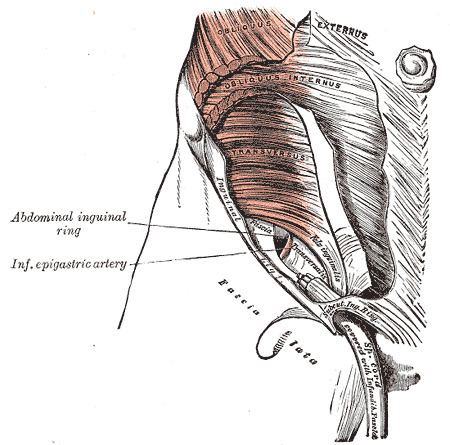Latin fascia transversalis TA A04.5.02.011 | Dorlands
/Elsevier f_03/12355646 FMA 12265 | |
 | ||
The transverse fascia (or transversalis fascia) is a thin aponeurotic membrane which lies between the inner surface of the transverse abdominal muscle and the parietal peritoneum.
Contents
It forms part of the general layer of fascia lining the abdominal parietes, and is directly continuous with the iliac fascia, internal spermatic, and pelvic fasciae.
In the inguinal region, the transverse fascia is thick and dense in structure and is joined by fibers from the aponeurosis of the transverse abdominal. It becomes thin as it ascends to the diaphragm and blends with the fascia covering the under surface of this muscle.
Borders
Behind, it is lost in the fat which covers the posterior surfaces of the kidneys.
Below, it has the following attachments: posteriorly, to the whole length of the iliac crest, between the attachments of the transverse abdominal and Iliacus; between the anterior superior iliac spine and the femoral vessels it is connected to the posterior margin of the inguinal ligament, and is there continuous with the iliac fascia.
Medial to the femoral vessels it is thin and attached to the pubis and pectineal line, behind the inguinal falx, with which it is united; it descends in front of the femoral vessels to form the anterior wall of the femoral sheath.
Beneath the inguinal ligament it is strengthened by a band of fibrous tissue, which is only loosely connected to the ligament, and is specialized as the iliopubic tract.
Opening
The spermatic cord in the male and the round ligament of the uterus in the female pass through the transverse fascia at the deep inguinal ring the entrance to the inguinal canal. This opening is not visible externally. In the male the transverse fascia extends downwards as the internal spermatic fascia.
